Economies of Scale: Definition, Types, and Economic Development
VerifiedAdded on 2020/07/22
|13
|3175
|83
Essay
AI Summary
This essay provides a comprehensive overview of economies of scale, defining its meaning and exploring its various types, including internal and external economies. It delves into the relationship between economies of scale and returns to scale, clarifying the differences between the two concepts. The essay examines the positive impacts of economies of scale, such as reduced production costs and improved efficiency, while also acknowledging potential negative aspects like diseconomies of scale. Furthermore, it illustrates how economies of scale can shape economic development, using examples like the Japanese motorcycle industry. The essay highlights the significance of economies of scale in various sectors and discusses its application in mergers and acquisitions, providing a well-rounded understanding of the subject.
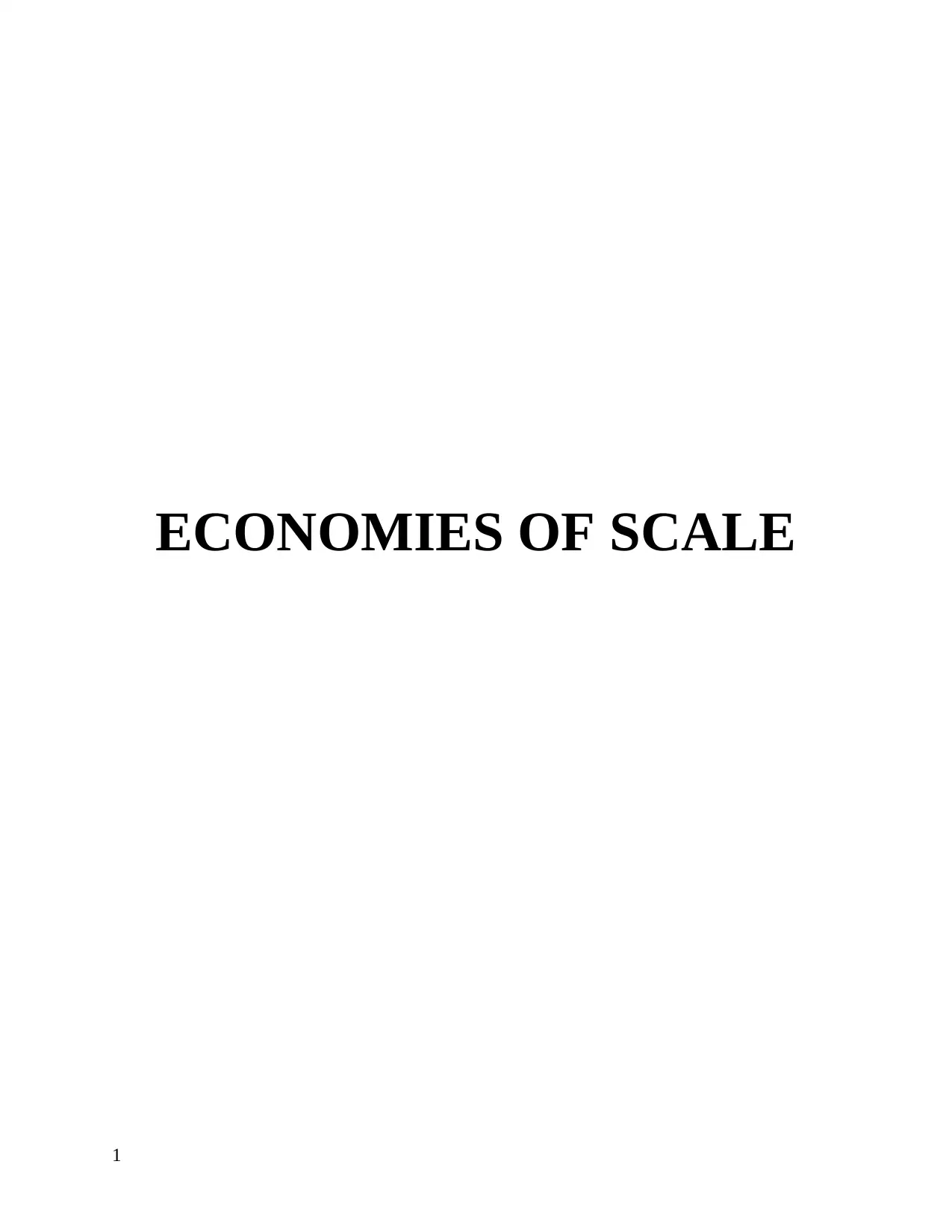
ECONOMIES OF SCALE
1
1
Paraphrase This Document
Need a fresh take? Get an instant paraphrase of this document with our AI Paraphraser
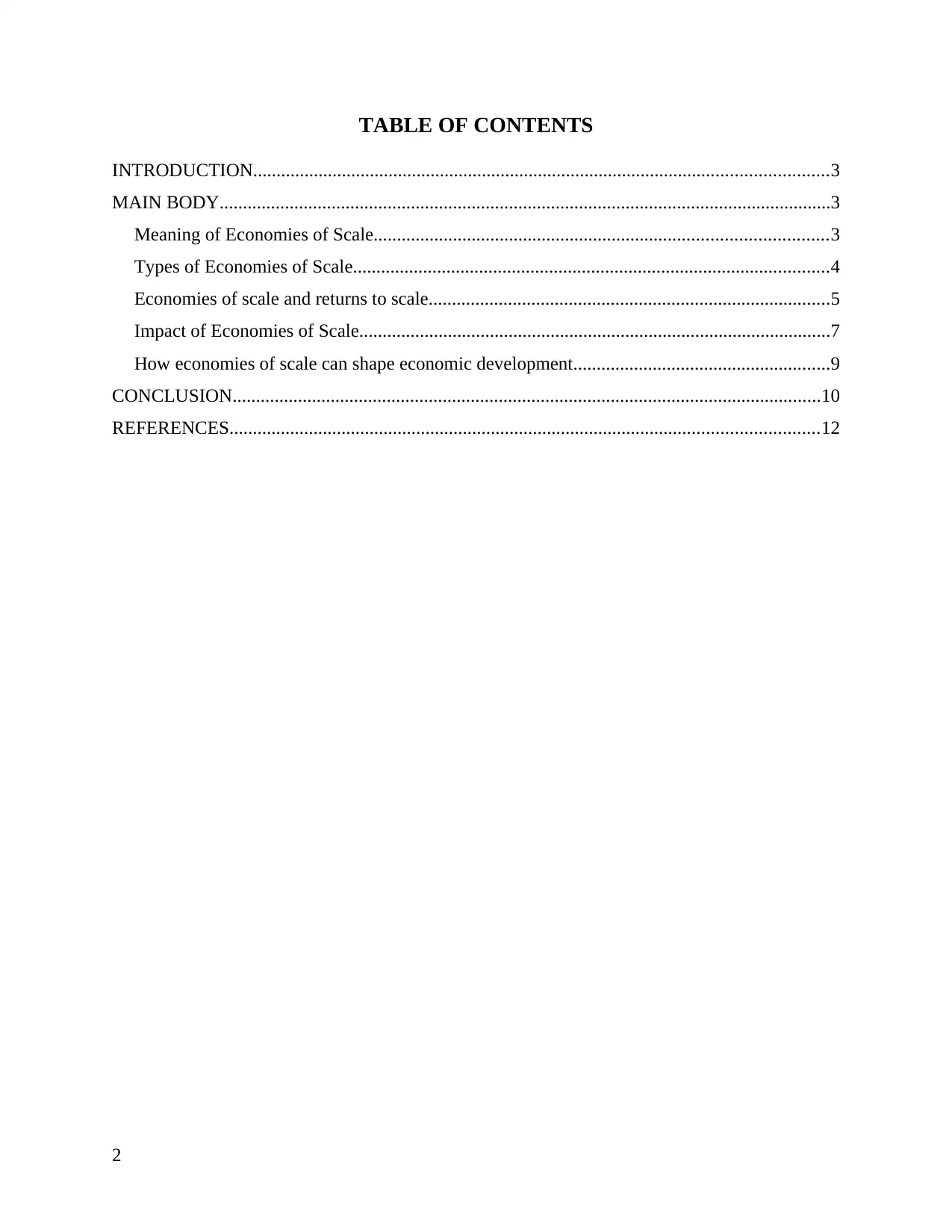
TABLE OF CONTENTS
INTRODUCTION...........................................................................................................................3
MAIN BODY...................................................................................................................................3
Meaning of Economies of Scale.................................................................................................3
Types of Economies of Scale......................................................................................................4
Economies of scale and returns to scale......................................................................................5
Impact of Economies of Scale.....................................................................................................7
How economies of scale can shape economic development.......................................................9
CONCLUSION..............................................................................................................................10
REFERENCES..............................................................................................................................12
2
INTRODUCTION...........................................................................................................................3
MAIN BODY...................................................................................................................................3
Meaning of Economies of Scale.................................................................................................3
Types of Economies of Scale......................................................................................................4
Economies of scale and returns to scale......................................................................................5
Impact of Economies of Scale.....................................................................................................7
How economies of scale can shape economic development.......................................................9
CONCLUSION..............................................................................................................................10
REFERENCES..............................................................................................................................12
2
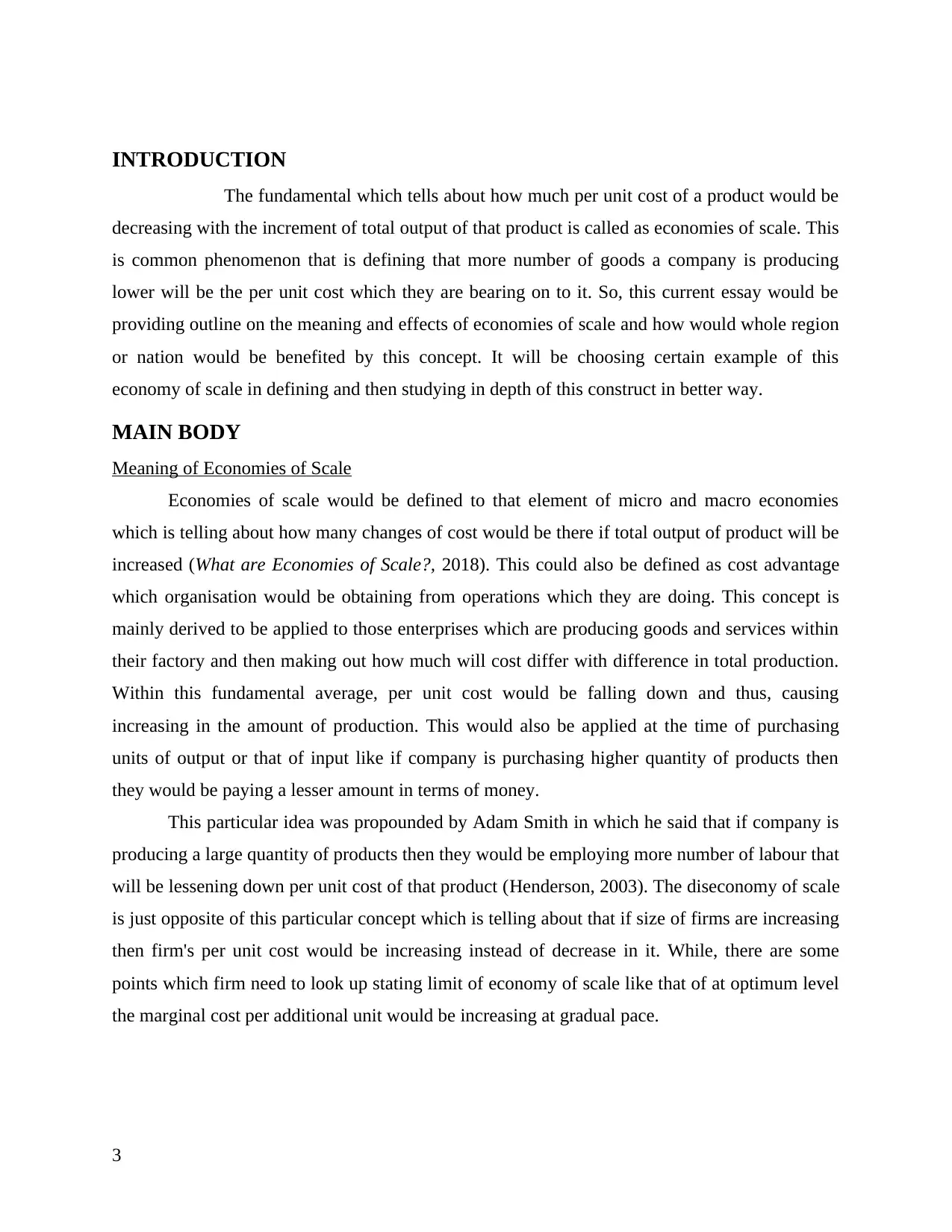
INTRODUCTION
The fundamental which tells about how much per unit cost of a product would be
decreasing with the increment of total output of that product is called as economies of scale. This
is common phenomenon that is defining that more number of goods a company is producing
lower will be the per unit cost which they are bearing on to it. So, this current essay would be
providing outline on the meaning and effects of economies of scale and how would whole region
or nation would be benefited by this concept. It will be choosing certain example of this
economy of scale in defining and then studying in depth of this construct in better way.
MAIN BODY
Meaning of Economies of Scale
Economies of scale would be defined to that element of micro and macro economies
which is telling about how many changes of cost would be there if total output of product will be
increased (What are Economies of Scale?, 2018). This could also be defined as cost advantage
which organisation would be obtaining from operations which they are doing. This concept is
mainly derived to be applied to those enterprises which are producing goods and services within
their factory and then making out how much will cost differ with difference in total production.
Within this fundamental average, per unit cost would be falling down and thus, causing
increasing in the amount of production. This would also be applied at the time of purchasing
units of output or that of input like if company is purchasing higher quantity of products then
they would be paying a lesser amount in terms of money.
This particular idea was propounded by Adam Smith in which he said that if company is
producing a large quantity of products then they would be employing more number of labour that
will be lessening down per unit cost of that product (Henderson, 2003). The diseconomy of scale
is just opposite of this particular concept which is telling about that if size of firms are increasing
then firm's per unit cost would be increasing instead of decrease in it. While, there are some
points which firm need to look up stating limit of economy of scale like that of at optimum level
the marginal cost per additional unit would be increasing at gradual pace.
3
The fundamental which tells about how much per unit cost of a product would be
decreasing with the increment of total output of that product is called as economies of scale. This
is common phenomenon that is defining that more number of goods a company is producing
lower will be the per unit cost which they are bearing on to it. So, this current essay would be
providing outline on the meaning and effects of economies of scale and how would whole region
or nation would be benefited by this concept. It will be choosing certain example of this
economy of scale in defining and then studying in depth of this construct in better way.
MAIN BODY
Meaning of Economies of Scale
Economies of scale would be defined to that element of micro and macro economies
which is telling about how many changes of cost would be there if total output of product will be
increased (What are Economies of Scale?, 2018). This could also be defined as cost advantage
which organisation would be obtaining from operations which they are doing. This concept is
mainly derived to be applied to those enterprises which are producing goods and services within
their factory and then making out how much will cost differ with difference in total production.
Within this fundamental average, per unit cost would be falling down and thus, causing
increasing in the amount of production. This would also be applied at the time of purchasing
units of output or that of input like if company is purchasing higher quantity of products then
they would be paying a lesser amount in terms of money.
This particular idea was propounded by Adam Smith in which he said that if company is
producing a large quantity of products then they would be employing more number of labour that
will be lessening down per unit cost of that product (Henderson, 2003). The diseconomy of scale
is just opposite of this particular concept which is telling about that if size of firms are increasing
then firm's per unit cost would be increasing instead of decrease in it. While, there are some
points which firm need to look up stating limit of economy of scale like that of at optimum level
the marginal cost per additional unit would be increasing at gradual pace.
3
⊘ This is a preview!⊘
Do you want full access?
Subscribe today to unlock all pages.

Trusted by 1+ million students worldwide
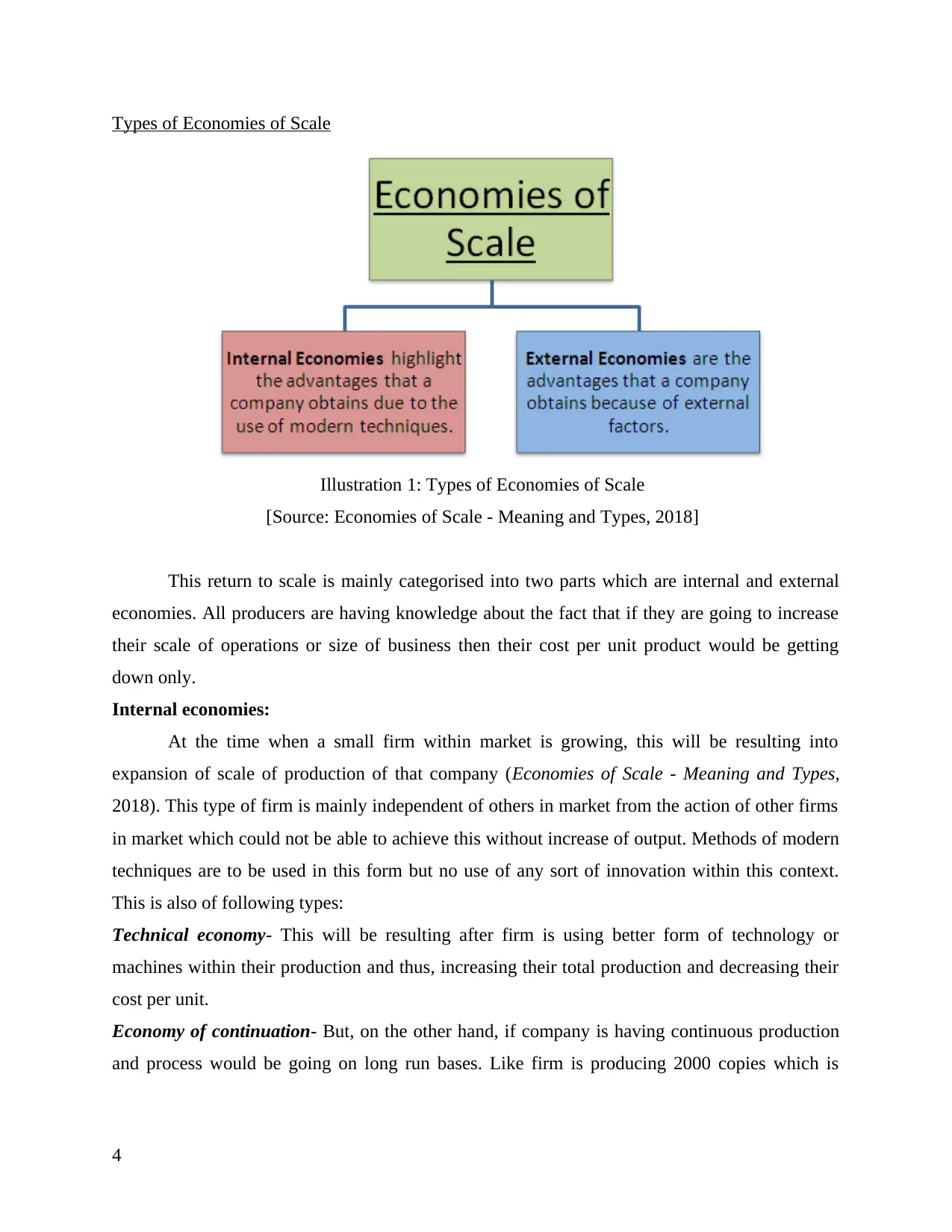
Types of Economies of Scale
This return to scale is mainly categorised into two parts which are internal and external
economies. All producers are having knowledge about the fact that if they are going to increase
their scale of operations or size of business then their cost per unit product would be getting
down only.
Internal economies:
At the time when a small firm within market is growing, this will be resulting into
expansion of scale of production of that company (Economies of Scale - Meaning and Types,
2018). This type of firm is mainly independent of others in market from the action of other firms
in market which could not be able to achieve this without increase of output. Methods of modern
techniques are to be used in this form but no use of any sort of innovation within this context.
This is also of following types:
Technical economy- This will be resulting after firm is using better form of technology or
machines within their production and thus, increasing their total production and decreasing their
cost per unit.
Economy of continuation- But, on the other hand, if company is having continuous production
and process would be going on long run bases. Like firm is producing 2000 copies which is
4
Illustration 1: Types of Economies of Scale
[Source: Economies of Scale - Meaning and Types, 2018]
This return to scale is mainly categorised into two parts which are internal and external
economies. All producers are having knowledge about the fact that if they are going to increase
their scale of operations or size of business then their cost per unit product would be getting
down only.
Internal economies:
At the time when a small firm within market is growing, this will be resulting into
expansion of scale of production of that company (Economies of Scale - Meaning and Types,
2018). This type of firm is mainly independent of others in market from the action of other firms
in market which could not be able to achieve this without increase of output. Methods of modern
techniques are to be used in this form but no use of any sort of innovation within this context.
This is also of following types:
Technical economy- This will be resulting after firm is using better form of technology or
machines within their production and thus, increasing their total production and decreasing their
cost per unit.
Economy of continuation- But, on the other hand, if company is having continuous production
and process would be going on long run bases. Like firm is producing 2000 copies which is
4
Illustration 1: Types of Economies of Scale
[Source: Economies of Scale - Meaning and Types, 2018]
Paraphrase This Document
Need a fresh take? Get an instant paraphrase of this document with our AI Paraphraser
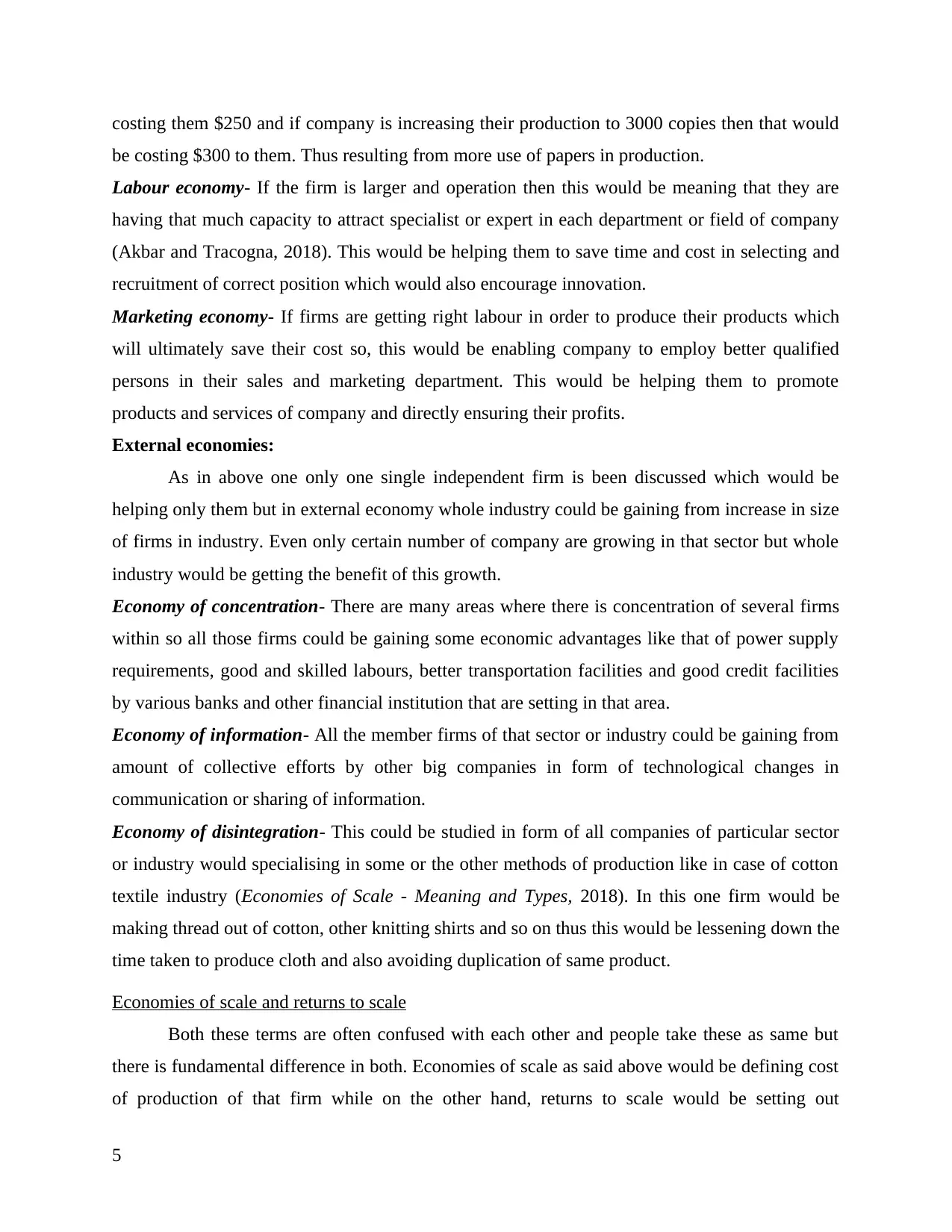
costing them $250 and if company is increasing their production to 3000 copies then that would
be costing $300 to them. Thus resulting from more use of papers in production.
Labour economy- If the firm is larger and operation then this would be meaning that they are
having that much capacity to attract specialist or expert in each department or field of company
(Akbar and Tracogna, 2018). This would be helping them to save time and cost in selecting and
recruitment of correct position which would also encourage innovation.
Marketing economy- If firms are getting right labour in order to produce their products which
will ultimately save their cost so, this would be enabling company to employ better qualified
persons in their sales and marketing department. This would be helping them to promote
products and services of company and directly ensuring their profits.
External economies:
As in above one only one single independent firm is been discussed which would be
helping only them but in external economy whole industry could be gaining from increase in size
of firms in industry. Even only certain number of company are growing in that sector but whole
industry would be getting the benefit of this growth.
Economy of concentration- There are many areas where there is concentration of several firms
within so all those firms could be gaining some economic advantages like that of power supply
requirements, good and skilled labours, better transportation facilities and good credit facilities
by various banks and other financial institution that are setting in that area.
Economy of information- All the member firms of that sector or industry could be gaining from
amount of collective efforts by other big companies in form of technological changes in
communication or sharing of information.
Economy of disintegration- This could be studied in form of all companies of particular sector
or industry would specialising in some or the other methods of production like in case of cotton
textile industry (Economies of Scale - Meaning and Types, 2018). In this one firm would be
making thread out of cotton, other knitting shirts and so on thus this would be lessening down the
time taken to produce cloth and also avoiding duplication of same product.
Economies of scale and returns to scale
Both these terms are often confused with each other and people take these as same but
there is fundamental difference in both. Economies of scale as said above would be defining cost
of production of that firm while on the other hand, returns to scale would be setting out
5
be costing $300 to them. Thus resulting from more use of papers in production.
Labour economy- If the firm is larger and operation then this would be meaning that they are
having that much capacity to attract specialist or expert in each department or field of company
(Akbar and Tracogna, 2018). This would be helping them to save time and cost in selecting and
recruitment of correct position which would also encourage innovation.
Marketing economy- If firms are getting right labour in order to produce their products which
will ultimately save their cost so, this would be enabling company to employ better qualified
persons in their sales and marketing department. This would be helping them to promote
products and services of company and directly ensuring their profits.
External economies:
As in above one only one single independent firm is been discussed which would be
helping only them but in external economy whole industry could be gaining from increase in size
of firms in industry. Even only certain number of company are growing in that sector but whole
industry would be getting the benefit of this growth.
Economy of concentration- There are many areas where there is concentration of several firms
within so all those firms could be gaining some economic advantages like that of power supply
requirements, good and skilled labours, better transportation facilities and good credit facilities
by various banks and other financial institution that are setting in that area.
Economy of information- All the member firms of that sector or industry could be gaining from
amount of collective efforts by other big companies in form of technological changes in
communication or sharing of information.
Economy of disintegration- This could be studied in form of all companies of particular sector
or industry would specialising in some or the other methods of production like in case of cotton
textile industry (Economies of Scale - Meaning and Types, 2018). In this one firm would be
making thread out of cotton, other knitting shirts and so on thus this would be lessening down the
time taken to produce cloth and also avoiding duplication of same product.
Economies of scale and returns to scale
Both these terms are often confused with each other and people take these as same but
there is fundamental difference in both. Economies of scale as said above would be defining cost
of production of that firm while on the other hand, returns to scale would be setting out
5
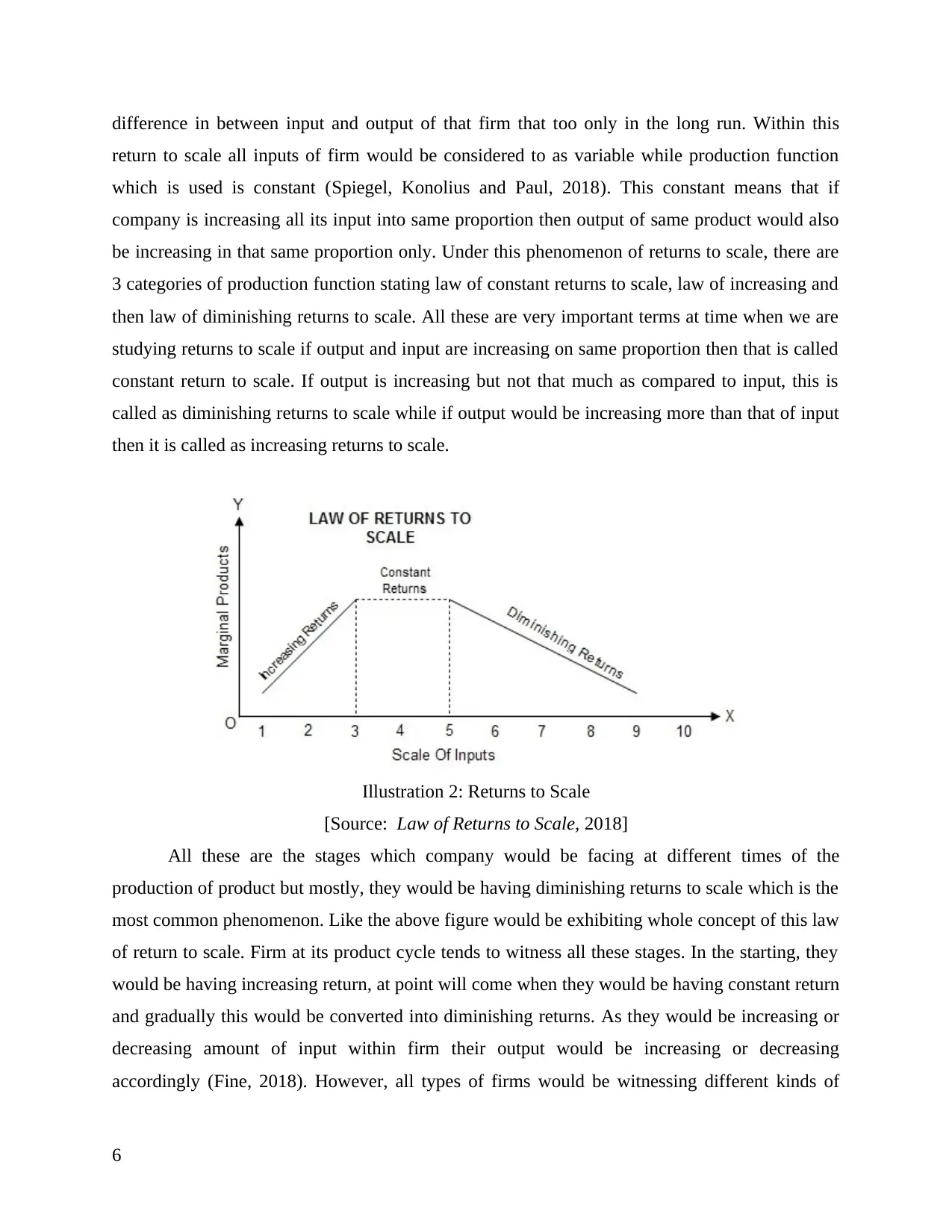
difference in between input and output of that firm that too only in the long run. Within this
return to scale all inputs of firm would be considered to as variable while production function
which is used is constant (Spiegel, Konolius and Paul, 2018). This constant means that if
company is increasing all its input into same proportion then output of same product would also
be increasing in that same proportion only. Under this phenomenon of returns to scale, there are
3 categories of production function stating law of constant returns to scale, law of increasing and
then law of diminishing returns to scale. All these are very important terms at time when we are
studying returns to scale if output and input are increasing on same proportion then that is called
constant return to scale. If output is increasing but not that much as compared to input, this is
called as diminishing returns to scale while if output would be increasing more than that of input
then it is called as increasing returns to scale.
All these are the stages which company would be facing at different times of the
production of product but mostly, they would be having diminishing returns to scale which is the
most common phenomenon. Like the above figure would be exhibiting whole concept of this law
of return to scale. Firm at its product cycle tends to witness all these stages. In the starting, they
would be having increasing return, at point will come when they would be having constant return
and gradually this would be converted into diminishing returns. As they would be increasing or
decreasing amount of input within firm their output would be increasing or decreasing
accordingly (Fine, 2018). However, all types of firms would be witnessing different kinds of
6
Illustration 2: Returns to Scale
[Source: Law of Returns to Scale, 2018]
return to scale all inputs of firm would be considered to as variable while production function
which is used is constant (Spiegel, Konolius and Paul, 2018). This constant means that if
company is increasing all its input into same proportion then output of same product would also
be increasing in that same proportion only. Under this phenomenon of returns to scale, there are
3 categories of production function stating law of constant returns to scale, law of increasing and
then law of diminishing returns to scale. All these are very important terms at time when we are
studying returns to scale if output and input are increasing on same proportion then that is called
constant return to scale. If output is increasing but not that much as compared to input, this is
called as diminishing returns to scale while if output would be increasing more than that of input
then it is called as increasing returns to scale.
All these are the stages which company would be facing at different times of the
production of product but mostly, they would be having diminishing returns to scale which is the
most common phenomenon. Like the above figure would be exhibiting whole concept of this law
of return to scale. Firm at its product cycle tends to witness all these stages. In the starting, they
would be having increasing return, at point will come when they would be having constant return
and gradually this would be converted into diminishing returns. As they would be increasing or
decreasing amount of input within firm their output would be increasing or decreasing
accordingly (Fine, 2018). However, all types of firms would be witnessing different kinds of
6
Illustration 2: Returns to Scale
[Source: Law of Returns to Scale, 2018]
⊘ This is a preview!⊘
Do you want full access?
Subscribe today to unlock all pages.

Trusted by 1+ million students worldwide
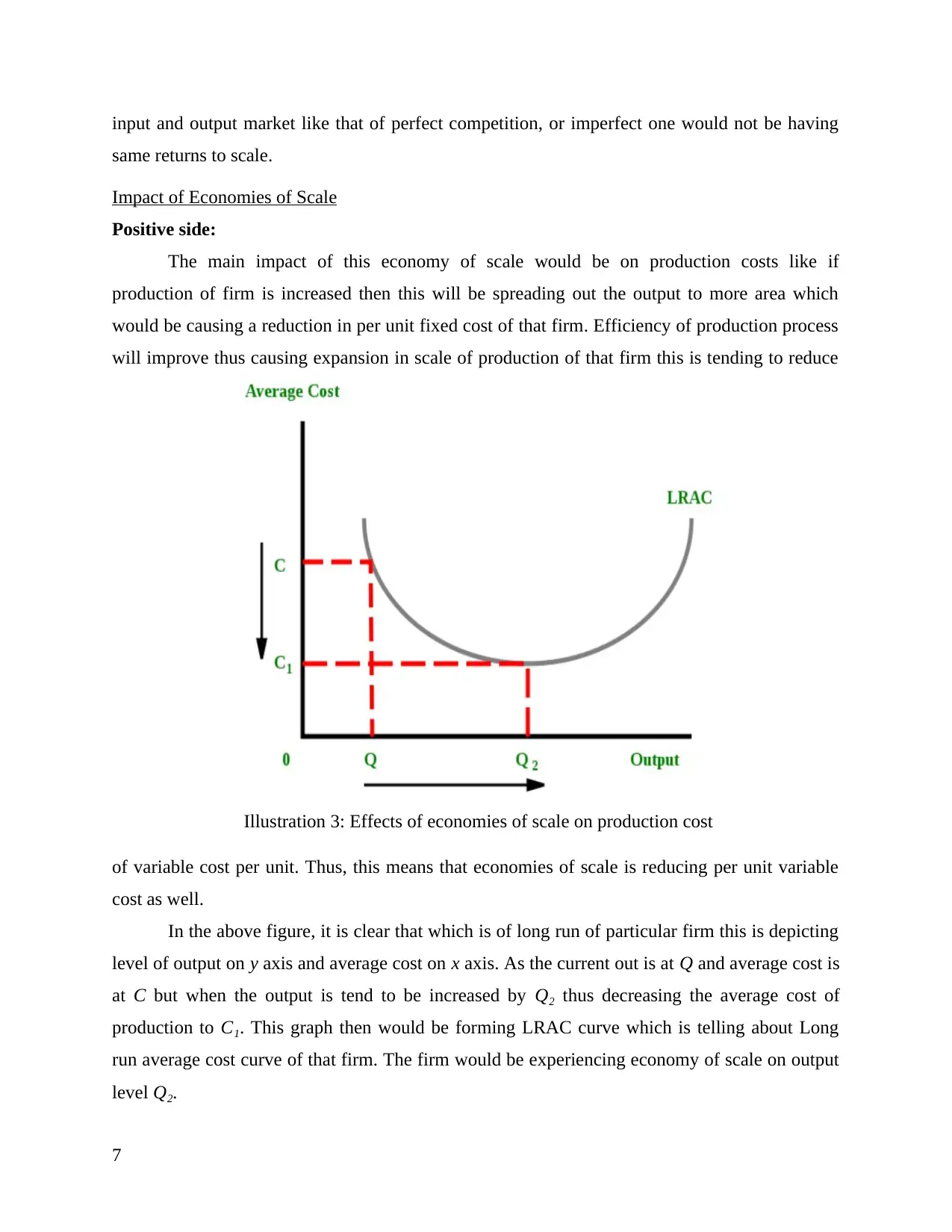
input and output market like that of perfect competition, or imperfect one would not be having
same returns to scale.
Impact of Economies of Scale
Positive side:
The main impact of this economy of scale would be on production costs like if
production of firm is increased then this will be spreading out the output to more area which
would be causing a reduction in per unit fixed cost of that firm. Efficiency of production process
will improve thus causing expansion in scale of production of that firm this is tending to reduce
of variable cost per unit. Thus, this means that economies of scale is reducing per unit variable
cost as well.
In the above figure, it is clear that which is of long run of particular firm this is depicting
level of output on y axis and average cost on x axis. As the current out is at Q and average cost is
at C but when the output is tend to be increased by Q₂ thus decreasing the average cost of
production to C₁. This graph then would be forming LRAC curve which is telling about Long
run average cost curve of that firm. The firm would be experiencing economy of scale on output
level Q₂.
7
Illustration 3: Effects of economies of scale on production cost
same returns to scale.
Impact of Economies of Scale
Positive side:
The main impact of this economy of scale would be on production costs like if
production of firm is increased then this will be spreading out the output to more area which
would be causing a reduction in per unit fixed cost of that firm. Efficiency of production process
will improve thus causing expansion in scale of production of that firm this is tending to reduce
of variable cost per unit. Thus, this means that economies of scale is reducing per unit variable
cost as well.
In the above figure, it is clear that which is of long run of particular firm this is depicting
level of output on y axis and average cost on x axis. As the current out is at Q and average cost is
at C but when the output is tend to be increased by Q₂ thus decreasing the average cost of
production to C₁. This graph then would be forming LRAC curve which is telling about Long
run average cost curve of that firm. The firm would be experiencing economy of scale on output
level Q₂.
7
Illustration 3: Effects of economies of scale on production cost
Paraphrase This Document
Need a fresh take? Get an instant paraphrase of this document with our AI Paraphraser
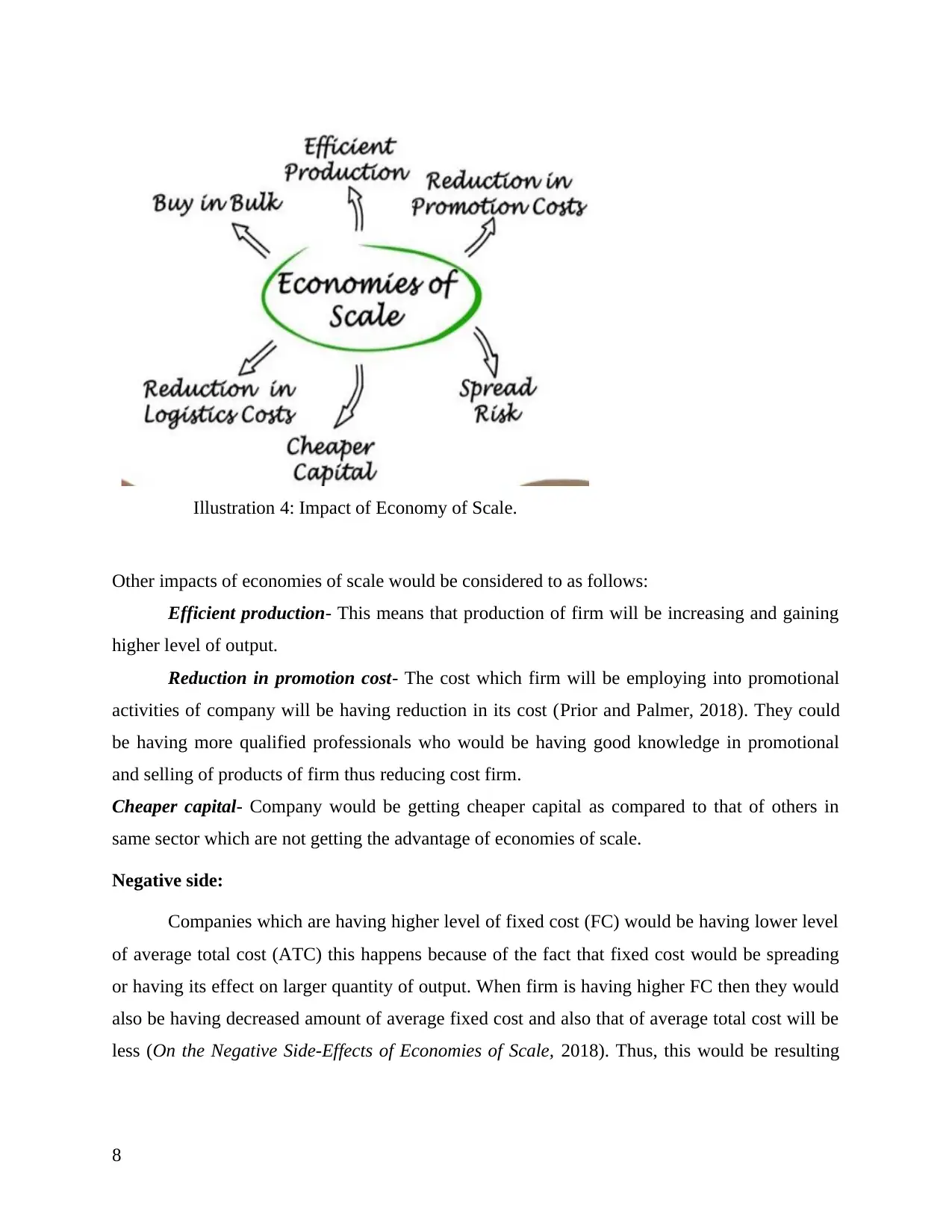
Other impacts of economies of scale would be considered to as follows:
Efficient production- This means that production of firm will be increasing and gaining
higher level of output.
Reduction in promotion cost- The cost which firm will be employing into promotional
activities of company will be having reduction in its cost (Prior and Palmer, 2018). They could
be having more qualified professionals who would be having good knowledge in promotional
and selling of products of firm thus reducing cost firm.
Cheaper capital- Company would be getting cheaper capital as compared to that of others in
same sector which are not getting the advantage of economies of scale.
Negative side:
Companies which are having higher level of fixed cost (FC) would be having lower level
of average total cost (ATC) this happens because of the fact that fixed cost would be spreading
or having its effect on larger quantity of output. When firm is having higher FC then they would
also be having decreased amount of average fixed cost and also that of average total cost will be
less (On the Negative Side-Effects of Economies of Scale, 2018). Thus, this would be resulting
8
Illustration 4: Impact of Economy of Scale.
Efficient production- This means that production of firm will be increasing and gaining
higher level of output.
Reduction in promotion cost- The cost which firm will be employing into promotional
activities of company will be having reduction in its cost (Prior and Palmer, 2018). They could
be having more qualified professionals who would be having good knowledge in promotional
and selling of products of firm thus reducing cost firm.
Cheaper capital- Company would be getting cheaper capital as compared to that of others in
same sector which are not getting the advantage of economies of scale.
Negative side:
Companies which are having higher level of fixed cost (FC) would be having lower level
of average total cost (ATC) this happens because of the fact that fixed cost would be spreading
or having its effect on larger quantity of output. When firm is having higher FC then they would
also be having decreased amount of average fixed cost and also that of average total cost will be
less (On the Negative Side-Effects of Economies of Scale, 2018). Thus, this would be resulting
8
Illustration 4: Impact of Economy of Scale.
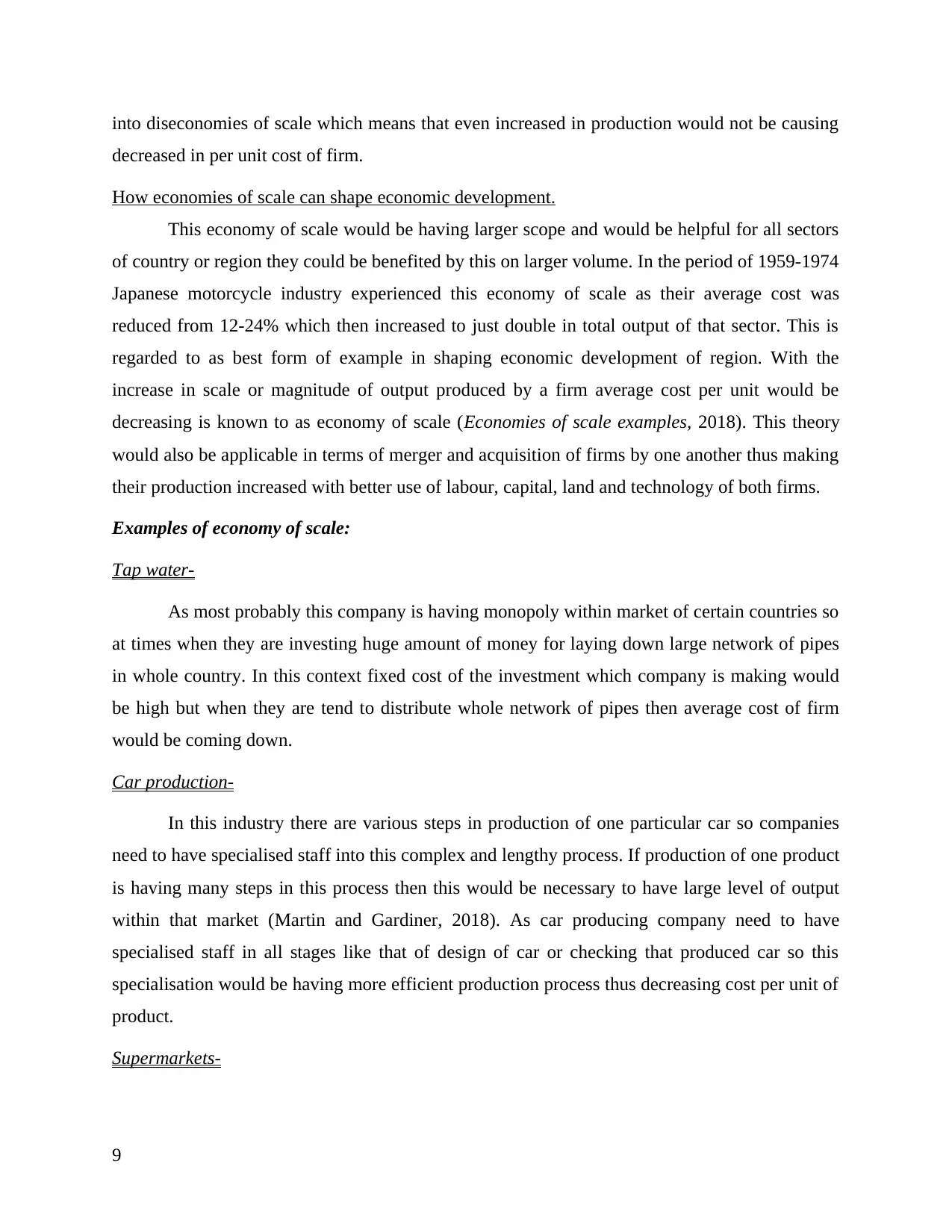
into diseconomies of scale which means that even increased in production would not be causing
decreased in per unit cost of firm.
How economies of scale can shape economic development.
This economy of scale would be having larger scope and would be helpful for all sectors
of country or region they could be benefited by this on larger volume. In the period of 1959-1974
Japanese motorcycle industry experienced this economy of scale as their average cost was
reduced from 12-24% which then increased to just double in total output of that sector. This is
regarded to as best form of example in shaping economic development of region. With the
increase in scale or magnitude of output produced by a firm average cost per unit would be
decreasing is known to as economy of scale (Economies of scale examples, 2018). This theory
would also be applicable in terms of merger and acquisition of firms by one another thus making
their production increased with better use of labour, capital, land and technology of both firms.
Examples of economy of scale:
Tap water-
As most probably this company is having monopoly within market of certain countries so
at times when they are investing huge amount of money for laying down large network of pipes
in whole country. In this context fixed cost of the investment which company is making would
be high but when they are tend to distribute whole network of pipes then average cost of firm
would be coming down.
Car production-
In this industry there are various steps in production of one particular car so companies
need to have specialised staff into this complex and lengthy process. If production of one product
is having many steps in this process then this would be necessary to have large level of output
within that market (Martin and Gardiner, 2018). As car producing company need to have
specialised staff in all stages like that of design of car or checking that produced car so this
specialisation would be having more efficient production process thus decreasing cost per unit of
product.
Supermarkets-
9
decreased in per unit cost of firm.
How economies of scale can shape economic development.
This economy of scale would be having larger scope and would be helpful for all sectors
of country or region they could be benefited by this on larger volume. In the period of 1959-1974
Japanese motorcycle industry experienced this economy of scale as their average cost was
reduced from 12-24% which then increased to just double in total output of that sector. This is
regarded to as best form of example in shaping economic development of region. With the
increase in scale or magnitude of output produced by a firm average cost per unit would be
decreasing is known to as economy of scale (Economies of scale examples, 2018). This theory
would also be applicable in terms of merger and acquisition of firms by one another thus making
their production increased with better use of labour, capital, land and technology of both firms.
Examples of economy of scale:
Tap water-
As most probably this company is having monopoly within market of certain countries so
at times when they are investing huge amount of money for laying down large network of pipes
in whole country. In this context fixed cost of the investment which company is making would
be high but when they are tend to distribute whole network of pipes then average cost of firm
would be coming down.
Car production-
In this industry there are various steps in production of one particular car so companies
need to have specialised staff into this complex and lengthy process. If production of one product
is having many steps in this process then this would be necessary to have large level of output
within that market (Martin and Gardiner, 2018). As car producing company need to have
specialised staff in all stages like that of design of car or checking that produced car so this
specialisation would be having more efficient production process thus decreasing cost per unit of
product.
Supermarkets-
9
⊘ This is a preview!⊘
Do you want full access?
Subscribe today to unlock all pages.

Trusted by 1+ million students worldwide
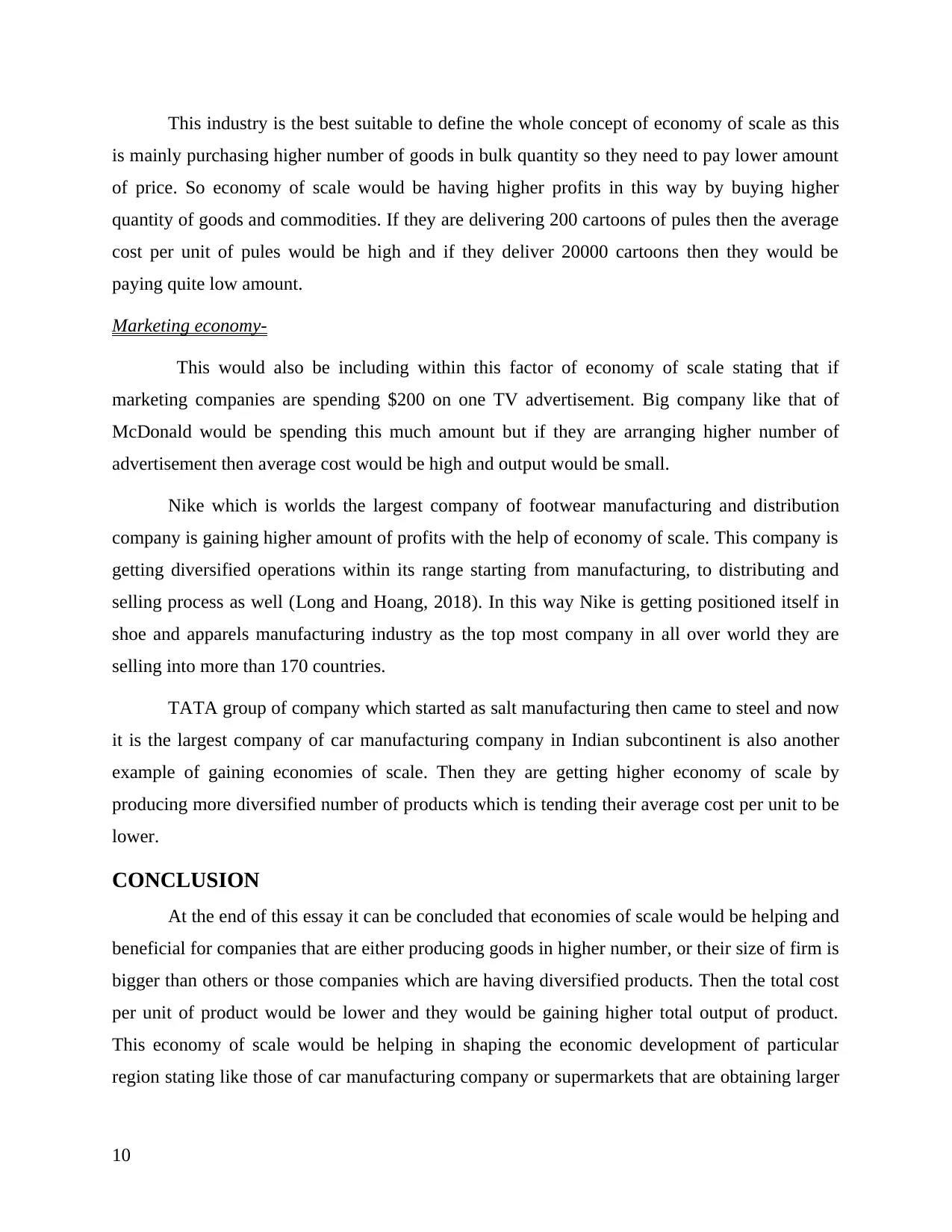
This industry is the best suitable to define the whole concept of economy of scale as this
is mainly purchasing higher number of goods in bulk quantity so they need to pay lower amount
of price. So economy of scale would be having higher profits in this way by buying higher
quantity of goods and commodities. If they are delivering 200 cartoons of pules then the average
cost per unit of pules would be high and if they deliver 20000 cartoons then they would be
paying quite low amount.
Marketing economy-
This would also be including within this factor of economy of scale stating that if
marketing companies are spending $200 on one TV advertisement. Big company like that of
McDonald would be spending this much amount but if they are arranging higher number of
advertisement then average cost would be high and output would be small.
Nike which is worlds the largest company of footwear manufacturing and distribution
company is gaining higher amount of profits with the help of economy of scale. This company is
getting diversified operations within its range starting from manufacturing, to distributing and
selling process as well (Long and Hoang, 2018). In this way Nike is getting positioned itself in
shoe and apparels manufacturing industry as the top most company in all over world they are
selling into more than 170 countries.
TATA group of company which started as salt manufacturing then came to steel and now
it is the largest company of car manufacturing company in Indian subcontinent is also another
example of gaining economies of scale. Then they are getting higher economy of scale by
producing more diversified number of products which is tending their average cost per unit to be
lower.
CONCLUSION
At the end of this essay it can be concluded that economies of scale would be helping and
beneficial for companies that are either producing goods in higher number, or their size of firm is
bigger than others or those companies which are having diversified products. Then the total cost
per unit of product would be lower and they would be gaining higher total output of product.
This economy of scale would be helping in shaping the economic development of particular
region stating like those of car manufacturing company or supermarkets that are obtaining larger
10
is mainly purchasing higher number of goods in bulk quantity so they need to pay lower amount
of price. So economy of scale would be having higher profits in this way by buying higher
quantity of goods and commodities. If they are delivering 200 cartoons of pules then the average
cost per unit of pules would be high and if they deliver 20000 cartoons then they would be
paying quite low amount.
Marketing economy-
This would also be including within this factor of economy of scale stating that if
marketing companies are spending $200 on one TV advertisement. Big company like that of
McDonald would be spending this much amount but if they are arranging higher number of
advertisement then average cost would be high and output would be small.
Nike which is worlds the largest company of footwear manufacturing and distribution
company is gaining higher amount of profits with the help of economy of scale. This company is
getting diversified operations within its range starting from manufacturing, to distributing and
selling process as well (Long and Hoang, 2018). In this way Nike is getting positioned itself in
shoe and apparels manufacturing industry as the top most company in all over world they are
selling into more than 170 countries.
TATA group of company which started as salt manufacturing then came to steel and now
it is the largest company of car manufacturing company in Indian subcontinent is also another
example of gaining economies of scale. Then they are getting higher economy of scale by
producing more diversified number of products which is tending their average cost per unit to be
lower.
CONCLUSION
At the end of this essay it can be concluded that economies of scale would be helping and
beneficial for companies that are either producing goods in higher number, or their size of firm is
bigger than others or those companies which are having diversified products. Then the total cost
per unit of product would be lower and they would be gaining higher total output of product.
This economy of scale would be helping in shaping the economic development of particular
region stating like those of car manufacturing company or supermarkets that are obtaining larger
10
Paraphrase This Document
Need a fresh take? Get an instant paraphrase of this document with our AI Paraphraser

number of total output but average cost of those goods are also lower. It is also clear from the
above essay that scope of this economy of scale is also larger which include like larger firms are
gaining more in long run as compared to short run as in this time average cost tend to be fixed.
11
above essay that scope of this economy of scale is also larger which include like larger firms are
gaining more in long run as compared to short run as in this time average cost tend to be fixed.
11
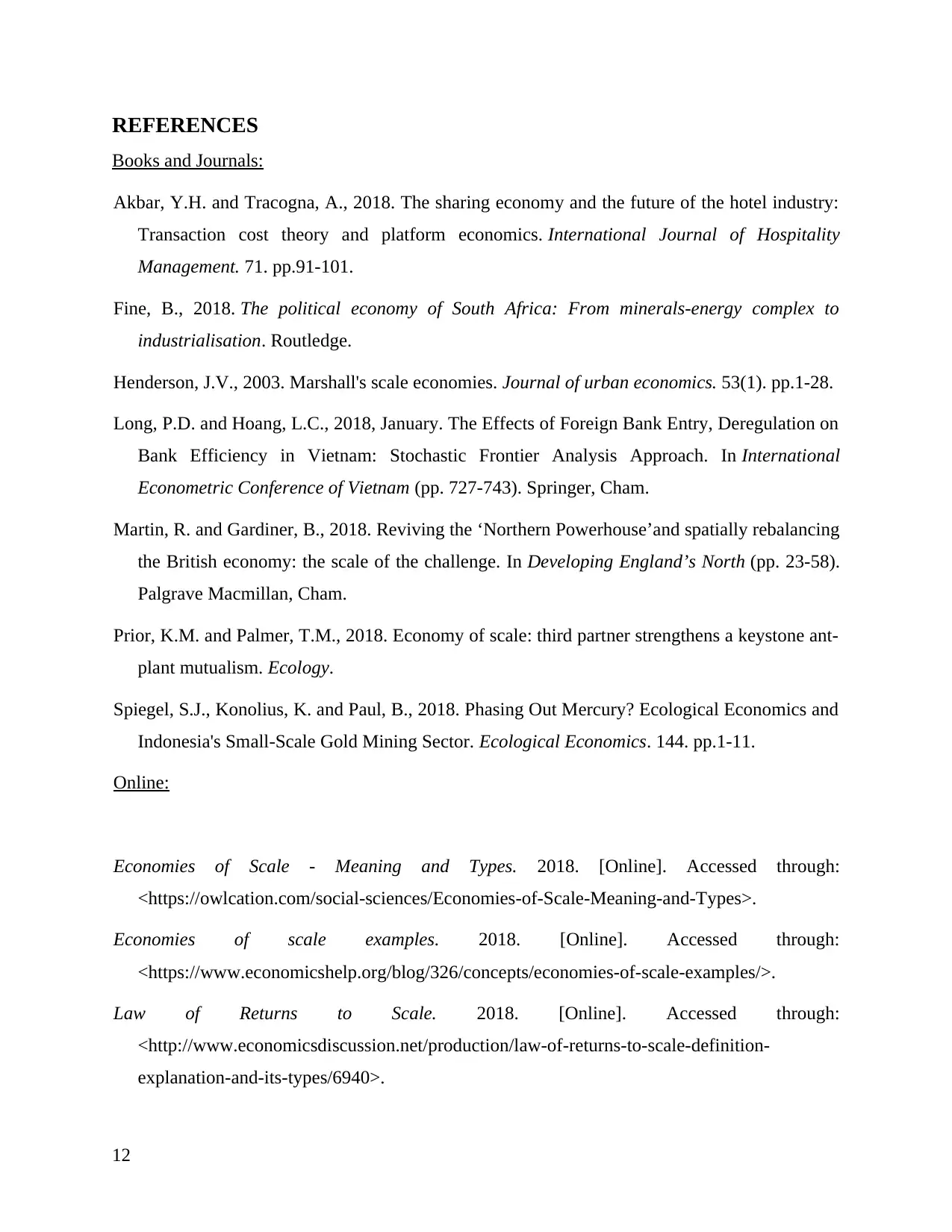
REFERENCES
Books and Journals:
Akbar, Y.H. and Tracogna, A., 2018. The sharing economy and the future of the hotel industry:
Transaction cost theory and platform economics. International Journal of Hospitality
Management. 71. pp.91-101.
Fine, B., 2018. The political economy of South Africa: From minerals-energy complex to
industrialisation. Routledge.
Henderson, J.V., 2003. Marshall's scale economies. Journal of urban economics. 53(1). pp.1-28.
Long, P.D. and Hoang, L.C., 2018, January. The Effects of Foreign Bank Entry, Deregulation on
Bank Efficiency in Vietnam: Stochastic Frontier Analysis Approach. In International
Econometric Conference of Vietnam (pp. 727-743). Springer, Cham.
Martin, R. and Gardiner, B., 2018. Reviving the ‘Northern Powerhouse’and spatially rebalancing
the British economy: the scale of the challenge. In Developing England’s North (pp. 23-58).
Palgrave Macmillan, Cham.
Prior, K.M. and Palmer, T.M., 2018. Economy of scale: third partner strengthens a keystone ant-
plant mutualism. Ecology.
Spiegel, S.J., Konolius, K. and Paul, B., 2018. Phasing Out Mercury? Ecological Economics and
Indonesia's Small-Scale Gold Mining Sector. Ecological Economics. 144. pp.1-11.
Online:
Economies of Scale - Meaning and Types. 2018. [Online]. Accessed through:
<https://owlcation.com/social-sciences/Economies-of-Scale-Meaning-and-Types>.
Economies of scale examples. 2018. [Online]. Accessed through:
<https://www.economicshelp.org/blog/326/concepts/economies-of-scale-examples/>.
Law of Returns to Scale. 2018. [Online]. Accessed through:
<http://www.economicsdiscussion.net/production/law-of-returns-to-scale-definition-
explanation-and-its-types/6940>.
12
Books and Journals:
Akbar, Y.H. and Tracogna, A., 2018. The sharing economy and the future of the hotel industry:
Transaction cost theory and platform economics. International Journal of Hospitality
Management. 71. pp.91-101.
Fine, B., 2018. The political economy of South Africa: From minerals-energy complex to
industrialisation. Routledge.
Henderson, J.V., 2003. Marshall's scale economies. Journal of urban economics. 53(1). pp.1-28.
Long, P.D. and Hoang, L.C., 2018, January. The Effects of Foreign Bank Entry, Deregulation on
Bank Efficiency in Vietnam: Stochastic Frontier Analysis Approach. In International
Econometric Conference of Vietnam (pp. 727-743). Springer, Cham.
Martin, R. and Gardiner, B., 2018. Reviving the ‘Northern Powerhouse’and spatially rebalancing
the British economy: the scale of the challenge. In Developing England’s North (pp. 23-58).
Palgrave Macmillan, Cham.
Prior, K.M. and Palmer, T.M., 2018. Economy of scale: third partner strengthens a keystone ant-
plant mutualism. Ecology.
Spiegel, S.J., Konolius, K. and Paul, B., 2018. Phasing Out Mercury? Ecological Economics and
Indonesia's Small-Scale Gold Mining Sector. Ecological Economics. 144. pp.1-11.
Online:
Economies of Scale - Meaning and Types. 2018. [Online]. Accessed through:
<https://owlcation.com/social-sciences/Economies-of-Scale-Meaning-and-Types>.
Economies of scale examples. 2018. [Online]. Accessed through:
<https://www.economicshelp.org/blog/326/concepts/economies-of-scale-examples/>.
Law of Returns to Scale. 2018. [Online]. Accessed through:
<http://www.economicsdiscussion.net/production/law-of-returns-to-scale-definition-
explanation-and-its-types/6940>.
12
⊘ This is a preview!⊘
Do you want full access?
Subscribe today to unlock all pages.

Trusted by 1+ million students worldwide
1 out of 13
Related Documents
Your All-in-One AI-Powered Toolkit for Academic Success.
+13062052269
info@desklib.com
Available 24*7 on WhatsApp / Email
![[object Object]](/_next/static/media/star-bottom.7253800d.svg)
Unlock your academic potential
Copyright © 2020–2025 A2Z Services. All Rights Reserved. Developed and managed by ZUCOL.




